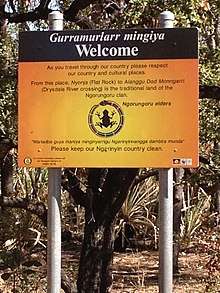Ngarinjin
The Ngarinjin or Ngarinyin, also known as the Ungarinyin, are an indigenous Australian people of northern Western Australia.

Language
Ngarinjin belongs to the Worrorran language family. As of 2003 there were 82 speakers of Ngarinjin spread out from Derby to the King River.[1]
Country
The Ngarinjin tribal lands were estimated by Norman Tindale to encompass some 10,500 square miles (27,000 km2) from Walcott Inlet at Mount Page. To the southeast their boundaries ran along the northern face of the King Leopold Ranges. Their land included the Isdell Valley to Isdell Range, running east as far as the Phillips Range, the headwaters of the Chapman River, Blackfellow Creek, and Wood River. Their confines to the north lay along the Barnett and Harris Ranges, and to where the Gibb River joins with the upper Drysdal across to the Maitland Range. They were present also at the King River headwaters, as far as around about Mount Reid. Their western frontier was set at Mounts Bradshaw and Han. Their territory to the southeast reached Mount French on the highlands.[2]
Social organization
The Ngarinjin were composed of roughly 40 hordes. Each of these local divisions had its own distinctive each with a clan and moiety classification.
History
Before the coming of white settlement, it appears that the Ngarinjin were pressing south into territory held by the Punaba.[2]
Ethnography
The German ethnographer Helmut Petri, during the Frobenius expedition of 1938-1939, lived among the Ngarinjin and took copious notes on the lore language and mythology of the Ngarinjin, and gathered many objects of their traditional craftsmanship. A large part of his material, conserved in Frankfurt am Main, was obliterated during one of the many Allied bombing runs on that city, which razed to the ground the Museum der Weltkulturen where Petri worked.[lower-alpha 1]
Alternative names
- Andedja.
- Andidja.
- Angarinjin.
- Arawari (a Worrorran word meaning 'southeastwards.')
- Arkarinjindja.
- Gular(a name applied to some hordes, with kular meaning 'west').
- Ingarinjindja (a Ngarinjin adult male)
- Marangana (of people who speak as the Ngarinjin do)
- Narrinyind.
- Ngaring-ngyan.
- Ngarinjin.
- Ngerringun Kandjalngari (northern horde name).[2]
- Njingarinjanja (a Ngarinjin adult female)
- Oladjau(Miriwung term for their language).
- Ungarinjin, Unrjarinjin (according to Tindale the Worrorra pronunciation)
- Ungarinyin, Ungarinjen.
- Walmidi. (Forrest River name)
- Wangarinjinu.
- Warnarinjin.
Notes
- 'Wertvolle Bestände, darunter ein großer Teil seiner Feldnotizen und Original texte von Mythen des Ungarinyin-Stammes, waren bei der Zerstörung des Instituts im Zweiten Weltkrieg vernichtet.'[3]
Citations
- Graves 2003, p. 380.
- Tindale 1974, p. 251.
- Michel 1988, p. vi.
Sources
- "AIATSIS map of Indigenous Australia". AIATSIS.
- Graves, B. (2003). "Wororan languages". In Frawley, William (ed.). International Encyclopedia of Linguistics: AAVE-Esperanto. Volume 1. Oxford University Press. pp. 379–380. ISBN 978-0-195-13977-8.CS1 maint: ref=harv (link)
- Michel, Thomas (1988). "Helmut Petri 1907–1986". Paideuma: Mitteilungen zur Kulturkunde. Frobenius Institute. 34: v–xiii. JSTOR 23076465.CS1 maint: ref=harv (link)
- "Tindale Tribal Boundaries" (PDF). Department of Aboriginal Affairs, Western Australia. September 2016.
- Tindale, Norman Barnett (1974). "Ngarinjin (WA)". Aboriginal Tribes of Australia: Their Terrain, Environmental Controls, Distribution, Limits, and Proper Names. Australian National University. ISBN 978-0-708-10741-6.CS1 maint: ref=harv (link)